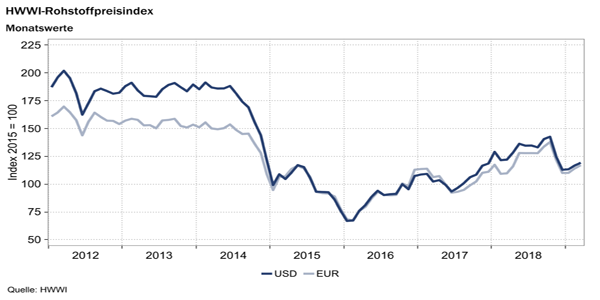Crude oil price continues to rise
- HWWI total index rose by 2.2 % (US dollar basis)
- Crude oil price increased by 4.3%
- Index for food and beverages declined
(Hamburg) In March, the HWWI commodity price index rose by an average of 2.2 % per month(in euros: +2.6 %) compared with the previous month. The HWWI commodity price index rose to 119.2 points (in euros: 117.0 points), 2.3 % (in euros: +6.7 %) lower than in March of last year. Only the index for energy raw materials showed growth in March, rising by 2.7 % (in euros: +3.1 %). The monthly average price of crude oil rose by 4.3 % (in euros: +4.7 %).In the two previous months, crude oil prices rose, while the prices of the other two energy raw materials fell. The index for industrial raw materials recorded slight losses. In March it fell by 0.4 % (in euro: ±0.0 %). The index for food and beverages fell much more sharply. It fell by 2.7 % (in euro: -2.3 %). The index excluding energy fell by 1.2 % (in euros: -0.7 %) to 111.7 points (in euros: 108.4 points).
Index for energy raw materials: +2.7 % (in euro: +3.1 %)
In March, the monthly average price of crude oil rose by 4.3% (in euros: +4.7%) to 64.02 US dollars (in euros: 56.64) per barrel compared with the previous month. High inventories and the uncertainty in the run-up to OPEC+ on 17 and 18 April meant that the price increase was weaker than in February. Once again, all reference grades listed in the index became more expensive. The strongest price increase was recorded fot the US crude oil of West Texas Intermediate (WTI). It rose by 5.7% (in euros: +6.2%), although it had the lowest price increase in the previous month. WTI’s price remains well below the March 2018 price, while the other two grades are above this price level.
The price of natural gas fell again. The average price of natural gas fell by 4.7 % (in euros: -4.3 %). European natural gas in particular fell in price. The oversupply in Asia caused LNG to be diverted to Europe. The price of European natural gas fell by 14.8 % (in euros: -14.4 %) and thus less sharply than in the previous month. By contrast, the monthly average price of US natural gas rose by 4.8 % (in euros: +4.7 %). The price of coal fell again in March, but less sharply than in the two previous months. The average monthly price for coal fell by an average of 2.8 % (in euros: -2.3 %), with South African coal becoming particularly cheaper. Technical problems in local coal-fired power plants led to a drop in demand and thus to falling prices. In addition, demand has been burdened for years by delays in the construction of two new coal-fired power plants in South Africa. Overall, the index for energy raw materials rose by 2.7 % (in euros: +3.1 %) to 120.6 points (in euros: 118.4 points). Once again, the rise in crude oil prices compensated for the price declines of the other two fossil fuels.
Index for industrial raw materials: -0.4 % (in euro: ±0.0 %)

The index for industrial raw materials is subdivided into the index for agricultural raw materials, the index for non-ferrous metals and the index for iron ore and steel scrap. In March, the index for agricultural raw materials fell by an average of 0.5% per month (in euro: ±0.0%). The price of rubber increased by 6.6% (in euro: +7.1%). The three largest rubber producers in the world – Thailand, Indonesia and Malaysia – agreed on supply reductions to stabilize the rubber price. The price of cotton rose by 5.0% (in euros: +5.4%), thus offsetting the fall in prices in January of this year. The current trade conflict between the USA and China is increasing Chinese demand for Indian cotton. A devaluation of the Indian rupee and high Indian domestic demand continue to support the positive price trend. The average monthly price of sawn timber fell by 6.5% (in euros: -6.1%).
After all base metal prices had risen in February, this price trend for all metals represented in the index, with the exception of lead, continued in March. On a monthly average, the lead price fell by 0.3% (in euro: +0.1%). Slight price increases were observed for aluminium and tin. On a monthly average, aluminium prices rose by 0.7% (in euro: +1.1%) and tin by 0.9% (in euro: +1.3%). The copper price rose by 2.8% (in euros: +3.2%) and nickel by 3.4% (in euros: +3.8%). The price of zinc rose particularly sharply due to low inventories. The price of zinc rose by 5.6% (in euros: +6.1%). Overall, the index for base metals rose by 1.8% (in euros: +2.3%). The index for iron ore and steel scrap fell by 3.3 % (in euro: -2.9 %), with steel scrap falling by 5.2 % (in euro: -4.8 %). Overall, the index for industrial raw materials fell by an average of -0.4% per month (in euros: ±0.0%) to 126.3 points (in euros: 124.0 points).
Index for food and beverages: -2.7 % (in euro: -2.3 %)
On a monthly average, prices for food and stimulants have fallen. Wheat prices fell particularly sharply. The lack of data due to the US government’s shutdown hampered the Agriculture Ministry’s forecast. After the shutdown had ended, the analyses were carried out in March. The planned wheat cultivation areas in the USA are larger than initially assumed. In addition, the warm winter means that expectations of future harvest volumes are rising. The Bexit, on the other hand, is depressing demand due to uncertainty about further imports into the United Kingdom. The demand for US wheat is hampered by the Transpacific Partnership (TTP), as wheat is increasingly in demand from Canada, Australia and the European Union (EU). The wheat price fell by 8.4% (in euro: -8.0%). After the palm oil price had risen significantly in February, it fell by an average of 6.1% in March (in euros: -5.7%). High inventories and concerns about the cultivation and use of palm oil are weighing on demand. In addition, the EU is considering sanctioning the import of palm oil. On average, coffee and cocoa prices fell more sharply than in the previous month. Coffee prices fell by 3.2% (in euros: -2.8%). The price of cocoa fell by 2.5% (in euro: -2.0%). Overall, the monthly average index for food and stimulants fell by 2.7% (in euros: -2.3%) to 87.4 points (in euros: 85.8 points).
